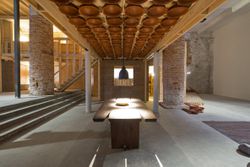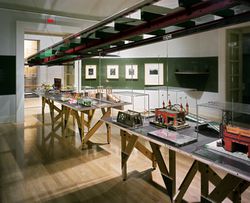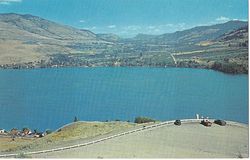Project
AP206.S1.1987.PR01
Description:
This project series documents the Thapar Institute of Science and Technology (TIET) in Patiala, India from 1987-1999. The project consisted of the master plan for the campus and the design of several buildings, not all of which were realized. These buildings included the girls' hostel, the residence for the warden of the girls' hostel, the post-graduate hostel, the polytechnic, the Science and Technology Entrepreneur Park (STEP) administration block, the lecture hall complex and a residence for lecturers, among others. Infrastructure such as walls, gates and signage were also included. The girls' hostel, post-graduate hostel, polytechnic and STEP administration block followed similar building layouts, each being square in shape with large courtyards at their centres. The two-storey girls' hostel had diamond shaped halls at two sides of the square that, at the ground floor, included the dining room and the common room. Verandas and terraces were featured prominently along the building's exterior. The post-graduate hostel and polytechnic followed a similar pattern, while the STEP administration block was much more compact with offices, lecture halls and meeting rooms. This project is recorded through drawings and textual records dating from 1987-2004. The drawings include plans, elevations, sections, perspectives and details, while the textual records consist of correspondence with the client, largely regarding finances and payments.
1987-2004
Thapar Institute of Engineering and Technology, Patiala, India (1987-1999)
Actions:
AP206.S1.1987.PR01
Description:
This project series documents the Thapar Institute of Science and Technology (TIET) in Patiala, India from 1987-1999. The project consisted of the master plan for the campus and the design of several buildings, not all of which were realized. These buildings included the girls' hostel, the residence for the warden of the girls' hostel, the post-graduate hostel, the polytechnic, the Science and Technology Entrepreneur Park (STEP) administration block, the lecture hall complex and a residence for lecturers, among others. Infrastructure such as walls, gates and signage were also included. The girls' hostel, post-graduate hostel, polytechnic and STEP administration block followed similar building layouts, each being square in shape with large courtyards at their centres. The two-storey girls' hostel had diamond shaped halls at two sides of the square that, at the ground floor, included the dining room and the common room. Verandas and terraces were featured prominently along the building's exterior. The post-graduate hostel and polytechnic followed a similar pattern, while the STEP administration block was much more compact with offices, lecture halls and meeting rooms. This project is recorded through drawings and textual records dating from 1987-2004. The drawings include plans, elevations, sections, perspectives and details, while the textual records consist of correspondence with the client, largely regarding finances and payments.
Project
1987-2004
Project
AP075.S1.1994.PR01
Description:
Project series documents Cornelia Hahn Oberlander's project of a roof garden for the New Canadian Embassy at Leipziger Platz in Berlin, Germany. Oberlander worked on this project in from 1999-2005 with architectural firm Kuwabara, Payne, McKenna, Blumberg Architects. Oberlander's work for the project included a terrace at the Ambassador's Level (6th floor) with mounded evergreen white flowering groundcover azaleas, cascading roses hanging along the Leipzigerstrasse facade, and a green roof on top of the building. The concept of the landscaping of the green roof was to represente Canada's land of the north in an abstract form, simulating the river system of the MacKenzie River in the Northwest Territories, linking Alberta to the Arctic Ocean. She used black-glass panels to represente the water. The drainage for the green roof was also connected the drainage infrastructure of the building to recycle the water collected from the roof. The project series includes sketches and design development drawings for the green roof landscaping, planting details and irrigation details, presentation drawings from KPMB and drawings of the building used as reference. The project is also documented through research material, concept notes by Oberlander, correspondence, including with architects, consultants, contractors and clients, proposal, specifications, and press clippings about the project. The project series also includes sample of glass tiles used for the landscaping.
1994-2005
New Canadian Embassy in Berlin, Germany (1994-2005)
Actions:
AP075.S1.1994.PR01
Description:
Project series documents Cornelia Hahn Oberlander's project of a roof garden for the New Canadian Embassy at Leipziger Platz in Berlin, Germany. Oberlander worked on this project in from 1999-2005 with architectural firm Kuwabara, Payne, McKenna, Blumberg Architects. Oberlander's work for the project included a terrace at the Ambassador's Level (6th floor) with mounded evergreen white flowering groundcover azaleas, cascading roses hanging along the Leipzigerstrasse facade, and a green roof on top of the building. The concept of the landscaping of the green roof was to represente Canada's land of the north in an abstract form, simulating the river system of the MacKenzie River in the Northwest Territories, linking Alberta to the Arctic Ocean. She used black-glass panels to represente the water. The drainage for the green roof was also connected the drainage infrastructure of the building to recycle the water collected from the roof. The project series includes sketches and design development drawings for the green roof landscaping, planting details and irrigation details, presentation drawings from KPMB and drawings of the building used as reference. The project is also documented through research material, concept notes by Oberlander, correspondence, including with architects, consultants, contractors and clients, proposal, specifications, and press clippings about the project. The project series also includes sample of glass tiles used for the landscaping.
Project
1994-2005
archives
Level of archival description:
Fonds
PGL architectes fonds
AP014
Synopsis:
Le fonds PGL architectes, 1959 – 1994, témoigne des activités de la firme d’architecture montréalaise, Papineau Gérin-Lajoie Le Blanc architectes, autant que ses sociétés affiliées et firmes remplaçantes. La majorité du fonds comprend des documents qui représentent 70 projets architecturaux, incluant des projets entrepris à travers le Québec, à Ottawa, à de multiples endroits au Nunavut, ainsi que des projets internationaux. Le fonds met en évidence la participation du PGL dans la construction d'infrastructure coloniale au Nunavik et au Nunavut, y compris les travaux sur des écoles associées avec des foyers fédéraux, qui sont reconnus comme faisant partie du système des pensionnats autochtones du Canada. De plus, le fonds documente l’utilisation des panneaux de fibre de verre modulaires employés par PGL. Pour la plupart, les documents dans ce fonds se composent des dessins, des documents photographiques, et des documents textuels. _____________________________________________________________________________________________________________ The PGL architectes fonds, 1959 - 1994, documents the work and activities of the Montréal-based architecture firm, Papineau Gérin-Lajoie Le Blanc architectes, and its successor and affiliate companies. The records within this fonds represent 70 architectural projects undertaken by the firm, which include projects throughout Québec, Ottawa, and various locations in Nunavut, as well as some international projects. The fonds offers evidence of PGL’s participation in the construction of colonial infrastructure in Nunavik and Nunavut, including work on schools that are connected to Federal Hostels which are recognised as part of Canada's Indian Residential School system. The fonds also contains records documenting PGL’s use of modular, fiberglass-reinforced plastic panels in construction. The records within this fonds largely consist of drawings, photographic materials, and textual records.
1959 - 1994
PGL architectes fonds
Actions:
AP014
Synopsis:
Le fonds PGL architectes, 1959 – 1994, témoigne des activités de la firme d’architecture montréalaise, Papineau Gérin-Lajoie Le Blanc architectes, autant que ses sociétés affiliées et firmes remplaçantes. La majorité du fonds comprend des documents qui représentent 70 projets architecturaux, incluant des projets entrepris à travers le Québec, à Ottawa, à de multiples endroits au Nunavut, ainsi que des projets internationaux. Le fonds met en évidence la participation du PGL dans la construction d'infrastructure coloniale au Nunavik et au Nunavut, y compris les travaux sur des écoles associées avec des foyers fédéraux, qui sont reconnus comme faisant partie du système des pensionnats autochtones du Canada. De plus, le fonds documente l’utilisation des panneaux de fibre de verre modulaires employés par PGL. Pour la plupart, les documents dans ce fonds se composent des dessins, des documents photographiques, et des documents textuels. _____________________________________________________________________________________________________________ The PGL architectes fonds, 1959 - 1994, documents the work and activities of the Montréal-based architecture firm, Papineau Gérin-Lajoie Le Blanc architectes, and its successor and affiliate companies. The records within this fonds represent 70 architectural projects undertaken by the firm, which include projects throughout Québec, Ottawa, and various locations in Nunavut, as well as some international projects. The fonds offers evidence of PGL’s participation in the construction of colonial infrastructure in Nunavik and Nunavut, including work on schools that are connected to Federal Hostels which are recognised as part of Canada's Indian Residential School system. The fonds also contains records documenting PGL’s use of modular, fiberglass-reinforced plastic panels in construction. The records within this fonds largely consist of drawings, photographic materials, and textual records.
archives
Level of archival description:
Fonds
1959 - 1994
archives
Level of archival description:
Fonds
Office dA project records
AP179
Synopsis:
The Office dA project records, 1991-2007, document the firm’s work on the Casa La Roca, Witte Arts Center, and Tongxian Arts Center projects. All three projects involved the use of traditional and locally-sourced materials, such as brick and terracotta block, to create continuous surfaces that appear structural despite remaining an architectural effect in the skin of the building. The archive consists of approximately 8362 digital files (8.5 GB), 1461 drawings and reproductions, four models and approximately 40 model pieces, as well as photographic materials, textual records and ephemera.
1991-2007
Office dA project records
Actions:
AP179
Synopsis:
The Office dA project records, 1991-2007, document the firm’s work on the Casa La Roca, Witte Arts Center, and Tongxian Arts Center projects. All three projects involved the use of traditional and locally-sourced materials, such as brick and terracotta block, to create continuous surfaces that appear structural despite remaining an architectural effect in the skin of the building. The archive consists of approximately 8362 digital files (8.5 GB), 1461 drawings and reproductions, four models and approximately 40 model pieces, as well as photographic materials, textual records and ephemera.
archives
Level of archival description:
Fonds
1991-2007
Building Knowledge
This lecture discusses a range of projects from Anupama Kundoo’s practice, research, and teaching. In these distinct but complementary areas of her work, she attempts to build collective knowledge in collaboration with engineers, masons, craftsmen, infrastructure providers, residents, material suppliers, and all other stakeholders involved in constructing and occupying(...)
Paul-Desmarais Theatre
16 April 2015 , 6pm
Building Knowledge
Actions:
Description:
This lecture discusses a range of projects from Anupama Kundoo’s practice, research, and teaching. In these distinct but complementary areas of her work, she attempts to build collective knowledge in collaboration with engineers, masons, craftsmen, infrastructure providers, residents, material suppliers, and all other stakeholders involved in constructing and occupying(...)
Paul-Desmarais Theatre
3 August 2023, 6pm to 7:30pm
archives
Level of archival description:
Fonds
AP175
Synopsis:
UNStudio Erasmus Bridge project records, 1990-1996, documents the design, conception and construction process for the Erasmus Bridge in Rotterdam, Netherlands. The records consist largely of textual records and technical drawings material in addition to born-digital material and two models.
1990-1996
UNStudio Erasmus Bridge project records
Actions:
AP175
Synopsis:
UNStudio Erasmus Bridge project records, 1990-1996, documents the design, conception and construction process for the Erasmus Bridge in Rotterdam, Netherlands. The records consist largely of textual records and technical drawings material in addition to born-digital material and two models.
archives
Level of archival description:
Fonds
1990-1996
Project
AP206.S1.1975.PR01
Description:
This project series documents Aditya Prakash's proposal for an alternative plan for Chandigarh, India, which came to be known as the Linear City. Prakash began developing and advocating for this idea around the early 1970s. The Linear City had two fundamental ideas at its core. The first was to raise the roadways in Chandigarh (or any future city) 10-12 feet from ground level. This, he proposed, would separate vehicular traffic from pedestrians, eliminating all the hazardous impacts of traffic on daily life. The large part of the drawings for this project show sector plans and city blocks with evenly dispersed roundabout roadways as major transit hubs, wrapping around but high above centres of pedestrian activity that included shops, markets and green spaces. The sale of the land below the roadways would pay for the upheaval. He also recommended building this city only a few sectors deep, but endlessly expanding it length-wise, with a raised canal along one side to provide an additional transpiration network and irrigation. The second fundamental idea of this city was the creation of self-sustaining sectors in the city plan, advocating that each neighbourhood should have the infrastructure to provide food and recycling for its residents. He fervently argued for the reimagination of modernist Chandigarh by incorporating sustainable, local traditions - the rural should exist in harmony with the urban. In opposition to Le Corbusier and Pierre Jeanneret, he believed areas for recycling, animal husbandry, and growing food should be incorporated into the fabric of the city.[1] This project is recorded largely through original drawings of city plans, perspectives and axonometric views detailing Prakash's new vision for the city. It seems that many of the perspectives were drawn by family friend Sandeep Virmani, after listening to Prakash's ideas.[2] The project is also recorded through photographs, negatives and slides showing plans and the project model. A small amount of notes and an article on the project are also included. [1]Vikramaditya Prakash, One Continuous Line: Art, Architecture and Urbanism of Aditya Prakash (Ahmedabad, India: Mapin Publishing Pvt. Ltd., 2019), 164-181. [2]Prakash, One Continuous Line, 169.
circa 1975-2003
Linear city, Chandigarh, India (circa 1975-1987)
Actions:
AP206.S1.1975.PR01
Description:
This project series documents Aditya Prakash's proposal for an alternative plan for Chandigarh, India, which came to be known as the Linear City. Prakash began developing and advocating for this idea around the early 1970s. The Linear City had two fundamental ideas at its core. The first was to raise the roadways in Chandigarh (or any future city) 10-12 feet from ground level. This, he proposed, would separate vehicular traffic from pedestrians, eliminating all the hazardous impacts of traffic on daily life. The large part of the drawings for this project show sector plans and city blocks with evenly dispersed roundabout roadways as major transit hubs, wrapping around but high above centres of pedestrian activity that included shops, markets and green spaces. The sale of the land below the roadways would pay for the upheaval. He also recommended building this city only a few sectors deep, but endlessly expanding it length-wise, with a raised canal along one side to provide an additional transpiration network and irrigation. The second fundamental idea of this city was the creation of self-sustaining sectors in the city plan, advocating that each neighbourhood should have the infrastructure to provide food and recycling for its residents. He fervently argued for the reimagination of modernist Chandigarh by incorporating sustainable, local traditions - the rural should exist in harmony with the urban. In opposition to Le Corbusier and Pierre Jeanneret, he believed areas for recycling, animal husbandry, and growing food should be incorporated into the fabric of the city.[1] This project is recorded largely through original drawings of city plans, perspectives and axonometric views detailing Prakash's new vision for the city. It seems that many of the perspectives were drawn by family friend Sandeep Virmani, after listening to Prakash's ideas.[2] The project is also recorded through photographs, negatives and slides showing plans and the project model. A small amount of notes and an article on the project are also included. [1]Vikramaditya Prakash, One Continuous Line: Art, Architecture and Urbanism of Aditya Prakash (Ahmedabad, India: Mapin Publishing Pvt. Ltd., 2019), 164-181. [2]Prakash, One Continuous Line, 169.
Project
circa 1975-2003
Toys and Transport
Every new transportation link and every change in systems of urban mobility introduces new infrastructure to the urban landscape: massive cuts enabling railway tracks to converge at a terminal or junction; wide railyards that service suburban and metropolitan transit systems; the proliferation of bridges, ramps, elevated highways, freeway cuts, parking lots, and even(...)
Octagonal gallery
15 November 2000 to 1 April 2001
Toys and Transport
Actions:
Description:
Every new transportation link and every change in systems of urban mobility introduces new infrastructure to the urban landscape: massive cuts enabling railway tracks to converge at a terminal or junction; wide railyards that service suburban and metropolitan transit systems; the proliferation of bridges, ramps, elevated highways, freeway cuts, parking lots, and even(...)
Octagonal gallery
Ben Bradley presents how the automobile shaped how Canadians encountered their country during the 20th century. As thousands and then millions came to know Canada by motoring, their travel patterns, viewing habits, and tastes shaped and reshaped the places they passed through. Canada’s roads came to be festooned with scenic pullouts, viewpoints, and a constellation of(...)
Paul Desmarais Theatre Keyword(s):
Canada, environment, Bradley, It's all happening so fast, roadside
23 February 2017, 6pm
Making Canada a Roadside Attraction
Actions:
Description:
Ben Bradley presents how the automobile shaped how Canadians encountered their country during the 20th century. As thousands and then millions came to know Canada by motoring, their travel patterns, viewing habits, and tastes shaped and reshaped the places they passed through. Canada’s roads came to be festooned with scenic pullouts, viewpoints, and a constellation of(...)
Paul Desmarais Theatre Keyword(s):
Canada, environment, Bradley, It's all happening so fast, roadside



